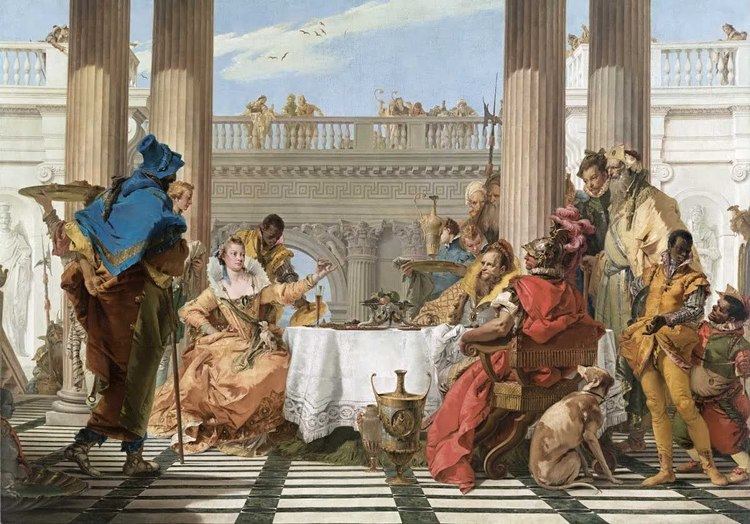Year 1744 Artist Giovanni Battista Tiepolo Period Rococo Media Canvas, Paint, Oil paint | Type Oil paint on canvas Created 1743–1744 Genre History painting | |
 | ||
Dimensions 250.3 by 357 centimetres (98.5 in × 140.6 in) Location National Gallery of Victoria, Melbourne Similar Giovanni Battista Tiepolo artwork, Rococo artwork, Oil paintings | ||
Giambattista tiepolo the banquet of cleopatra
The Banquet of Cleopatra is a painting by Giovanni Battista Tiepolo completed in 1744. It is now in the National Gallery of Victoria in Melbourne, Australia.
Contents
The work depicts the culmination of a wager between Cleopatra and Mark Antony as to which one could provide the most expensive feast. As recounted in Pliny the Elder's Natural History she wins the wager: after Mark Antony's feast, Cleopatra drops a rare and precious pearl from her earring into a cup of vinegar and drinks it once the pearl has dissolved. The third person at the table is Lucius Munatius Plancus, at the time Antony's ally, who was to decide the winner of the wager.
This is the first of three large paintings of the subject done by Tiepolo. In addition the much smaller oil studies or modelli for each survive.
In art
The subject had been painted by various artists, especially in Italian palace decoration and in Dutch Golden Age painting and Flemish Baroque painting, with a version by Jacob Jordaens (1653, Hermitage Museum); one by Gérard de Lairesse (late 1670s, Rijksmuseum); two versions by Jan de Bray, using his own family, including himself, as models (Royal Collection, 1652, and Currier Museum of Art, New Hampshire, 1669). In between the two versions most of those depicted had died in an outbreak of plague, making the later version largely a memorial portrait. Other artists included Gerard Hoet, who painted three versions of the subject in the early 18th century (two are in the Getty Center and Bayreuth, Germany).
In both the Italian and northern traditions the subject fitted well into existing genres showing lavish dining, with the added attraction of making a more prestigious history painting with an impeccable and exotic classical origin. It often formed part of cycles on Antony and Cleopatra with other subjects including the Meeting of Cleopatra and Mark Anthony, the Death of Cleopatra, and sometimes her meetings with Julius Caesar and Octavian.
Tiepolo
Tiepolo returned to the subject a few years later at the Palazzo Labia in Venice with his frescos on Antony and Cleopatra: the Banquet was paired with a Meeting of Cleopatra and Mark Anthony and surrounding scenes of gods and attendants. Two further large oils by Tiepolo of these scenes are in Arkhangelskoye Palace near Moscow (1747, 338 x 600 cm).
Tiepolo typically made oil sketch modelli with varying degrees of finish to show his composition and, perhaps, submit it for approval to the client. The modello for the Melbourne painting is in the Musée Cognacq-Jay in Paris, and was owned by Count Francesco Algarotti until his death. There is a small (46.3 by 66.7 centimetres (18.2 in × 26.3 in)) oil sketch by Tiepolo in the National Gallery, London, which may relate to the Palazzo Labia, although it differs considerably from the work in Venice, and it is more usually regarded as a study for the Archangelskoye painting. There is another small oil in the collection of Stockholm University in Sweden, a modello for the Palazzo Labia composition, and there are a number of preparatory drawings in various collections.
All three large compositions show the banquet taking place in the open air or a loggia with a grand architectural setting but with the sky visible, and include a raised terrace closing off the back of the pictorial space. In the Palazzo Labia and Arkhangelskoye paintings (and the Paris and London modelli) there are steps in the foreground leading up to the dining table; although the Melbourne painting lacks these steps, the pattern of the marble floor gives a similar visual effect. Only the two or three main figures are seated, but various attendants stand around them. All the compositions show a clear debt to the grandly theatrical feast paintings of Paolo Veronese, nearly a century earlier, such as The Wedding at Cana (1563, Louvre) and The Feast in the House of Levi (1573, Accademia, Venice). Venetian taste approved of such explicit reference to the city's artistic tradition. In the Palazzo Labia the frescos were designed in conjunction with a scheme of trompe l'oeil architecture by Gerolamo Mengozzi Colonna embracing the whole space. The frescos come almost down to the floor, so that the steps bring the main scene up to a height where they could be seen across a crowded room.
Provenance
The Melbourne painting was commissioned for Frederick Augustus III, Elector of Saxony, by his agent Francesco Algarotti. According to a letter of 1744 from Algarotti to Heinrich von Brühl (1700–1763), the Saxon chief minister, he saw it unfinished in Tiepolo's studio, where it had been commissioned by someone else, and persuaded Tiepolo to finish it for Dresden. It has been speculated that the original commissioner was the English "Consul Smith".
It was acquired in 1764 by Catherine the Great in Amsterdam. The work remained in the collection of the Hermitage Museum in what was then Saint Petersburg and later became Leningrad. It was part of the Soviet sale of Hermitage paintings, and was purchased by an English art dealer in 1932. It was purchased by the National Gallery of Victoria in 1933 for A£25,000; according to some accounts the National Gallery in London wanted the painting, but stood aside to allow Melbourne to improve their collection.
